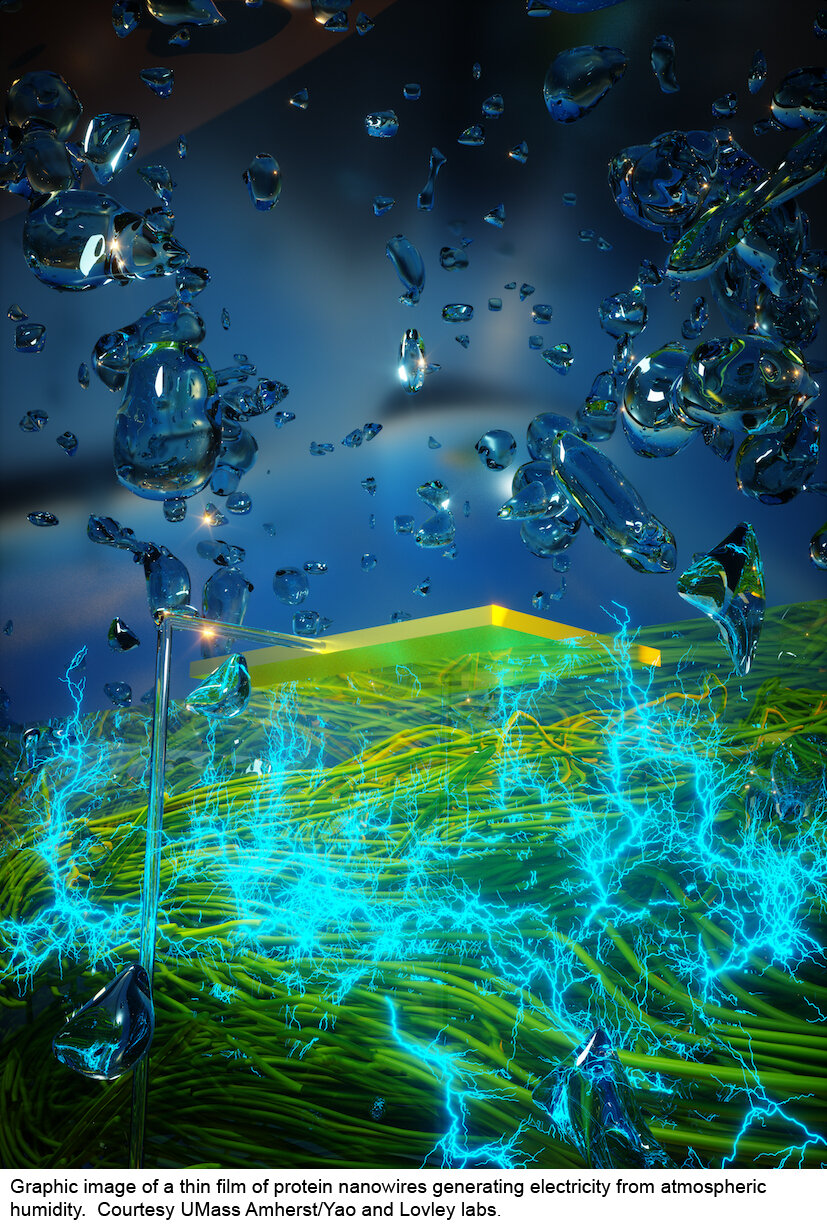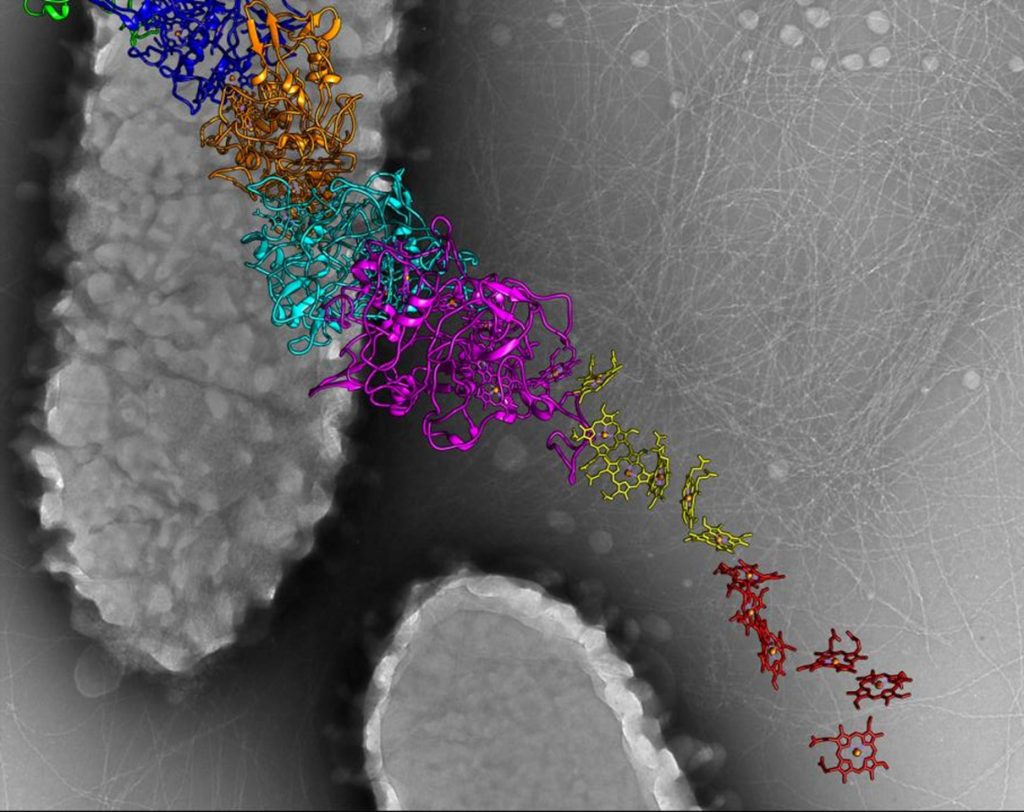博文
Nat.: 借空气发电的新绿色技术
|||
Nat.: 借空气发电的新绿色技术
诸平

Fig. 1 Graphic image of a thin film of protein nanowires generating electricity from atmospheric humidity. UMass Amherst researchers say the device can literally make electricity out of thin air. Credit: UMass Amherst/Yao and Lovley labs

Fig. 2 Geobacter sulfurreducens
据美国麻省大学阿默斯特分校(University of Massachusetts Amherst, UMass Amherst)2020年2月17日提供的消息,该校的研究人员开发了一种设备,该设备使用天然蛋白质从空气中的水分中产生电能(电流密度为17 mA/cm2)。图1是UMass Amherst的姚军(Jun Yao音译)和Derek R. Lovley实验室提供的照片,它是从大气湿度发电的蛋白质纳米线薄膜的图像。UMass Amherst的研究人员说,该设备实际上可以凭空气产生电能。相关研究结果于2020年2月17日在《自然》(Nature)杂志网站上发表——Xiaomeng Liu, Hongyan Gao, Joy E. Ward, Xiaorong Liu, Bing Yin, Tianda Fu, Jianhan Chen, Derek R. Lovley, Jun Yao. Power generation from ambient humidity using protein nanowires. Nature, (2020). DOI: 10.1038/s41586-020-2010-9. Published: 17 February 2020
参与此项研究的有来自麻省大学阿默斯特分校电气与计算机工程系(Department of Electrical and Computer Engineering)、微生物系(Department of Microbiology)、化学系(Department of Chemistry)、应用生命科学研究所(Institute for Applied Life Sciences, IALS)以及生物化学与分子生物学系(Department of Biochemistry and Molecular Biology)的研究人员。他们说,这项新技术可能对可再生能源、气候变化以及医学的未来产生重大影响。
正如《自然》杂志当天报道的那样,位于UMass Amherst的电气工程师姚军和微生物学家Derek R. Lovley的实验室已经创造出一种被称为"Air-gen"的气动发电机(air-powered generator),配有由微生物地杆菌(Geobacter sulfurreducens)生产的导电蛋白纳米线。Air-gen将电极连接到蛋白质纳米线,使得从大气中自然存在的水蒸气产生电流。
姚军说:“我们实际上是凭空气来发电。” “Air-gen产生24/7的清洁能源。” Derek R. Lovley拥有超过30年的先进的基于可持续的生物电子材料的研究经验。他补充说:“这是迄今为止蛋白质纳米线最令人惊讶和激动人心的应用。”
姚军的实验室开发的新技术是无污染、可再生和低成本的。即使在湿度极低的地区(例如撒哈拉沙漠),Air-gen也可以发电。Derek R. Lovley说,与其他形式的可再生能源(包括太阳能和风能)相比,Air-gen具有显著优势,因为与其他可再生能源不同,Air-gen不需要阳光或风,“甚至可以在室内使用”。
研究人员解释说,Air-gen设备仅需要厚度不足10 μm的蛋白质纳米线薄膜。薄膜的底部位于电极上,而仅覆盖部分纳米线薄膜的较小电极位于顶部。该膜吸收来自大气的水蒸气。蛋白质纳米线的电导率和表面化学的结合,再加上薄膜中纳米线之间的细孔,共同建立了在两个电极之间产生电流的条件。
研究人员说,当前一代的Air-gen设备能够为小型电子设备供电,他们希望很快将这项发明推向商业规模。他们计划的下一步包括开发一个小型的Air-gen“补丁”,该补丁可以为电子可穿戴设备供电,例如健康和健身监视器以及智能手表,这将消除对传统电池的需求。他们还希望开发Air-gens应用于手机,以取代周期性充电。
姚军说:“最终的目标是制造大型系统。例如,该技术可能会整合到可以为您的房屋供电的墙面涂料中,或者,我们可能会开发独立的气动发电机来为房屋供电。一旦我们达到电线生产的工业规模,我完全希望我们可以制造大型系统,这将对可持续能源生产做出重大贡献。”
为了继续提高地杆菌(Geobacter sulfurreducens)的实用生物功能,Derek R. Lovley的实验室最近开发了一种新的微生物菌株,可以更快速、更便宜地批量生产蛋白质纳米线。他说:“我们将大肠杆菌(E. coli)变成了蛋白质纳米线工厂。” “通过这种新的可扩展流程,蛋白质纳米线的供应将不再成为开发这些应用项目的瓶颈。”
他们说,Air-gen的发现反映出一种不寻常的跨学科合作。Derek R. Lovley于30多年前在波托马克河(Potomac River)的泥浆中发现了地杆菌属(Geobacter sulfurreducens)微生物。他的实验室后来发现了其生产超细导电蛋白纳米线的能力。而姚军在入职UMass Amherst之前,在哈佛大学(Harvard University)工作了多年,在那里他用硅纳米线设计出电子设备。现在他们联合起来,看看是否可以用从硫还原地杆菌(Geobacter sulfurreducens)收集的蛋白质纳米线制造有用的电子设备。
刘晓梦(Xiaomeng Liu音译)是姚军实验室的一名正在开发传感器设备的博士生,也是发表于《自然》杂志论文的第一作者,据他自己回忆当时的意外发现,他说:“我发现当纳米线以特定方式与电极接触时,设备会产生电流。我发现暴露于大气湿度是必不可少的条件,蛋白质纳米线会吸收水,从而在设备上产生电压梯度。”
除了Air-gen,姚军的实验室还利用蛋白质纳米线(protein nanowires)开发了其他几种应用项目。姚军说:“这仅仅是基于蛋白质的电子设备新时代的开始。”更多信息请注意浏览原文或者相关报道。
INNOVATION: Novel device can generate electricity from air using bacterial protein,says study
New green technology from UMass Amherst generates electricity 'out of thin air'
Novel device can generate electricity from air using bacterial protein: Study
Scientists make new 'green' electronic polymer-based films with protein nanowires
Abstract
Harvesting energy from the environment offers the promise of clean power for self-sustained systems1,2. Known technologies—such as solar cells, thermoelectric devices and mechanical generators—have specific environmental requirements that restrict where they can be deployed and limit their potential for continuous energy production3,4,5. The ubiquity of atmospheric moisture offers an alternative. However, existing moisture-based energy-harvesting technologies can produce only intermittent, brief (shorter than 50 seconds) bursts of power in the ambient environment, owing to the lack of a sustained conversion mechanism6,7,8,9,10,11,12. Here we show that thin-film devices made from nanometre-scale protein wires harvested from the microbe Geobacter sulfurreducens can generate continuous electric power in the ambient environment. The devices produce a sustained voltage of around 0.5 volts across a 7-micrometre-thick film, with a current density of around 17 microamperes per square centimetre. We find the driving force behind this energy generation to be a self-maintained moisture gradient that forms within the film when the film is exposed to the humidity that is naturally present in air. Connecting several devices linearly scales up the voltage and current to power electronics. Our results demonstrate the feasibility of a continuous energy-harvesting strategy that is less restricted by location or environmental conditions than other sustainable approaches.
https://blog.sciencenet.cn/blog-212210-1219151.html
上一篇:绿茶提取物+运动可对付小鼠脂肪肝疾病
下一篇:氟牙症的新解释:过多的氟化物会导致牙釉质缺损